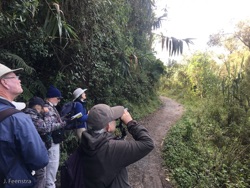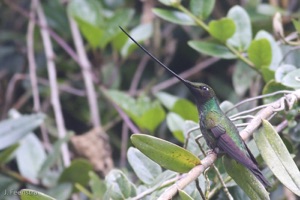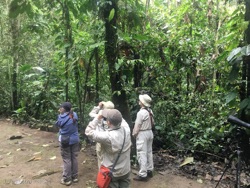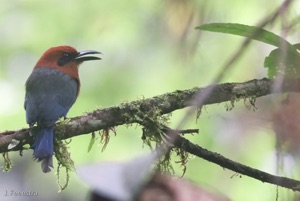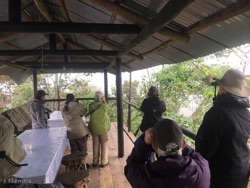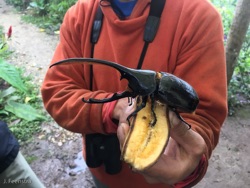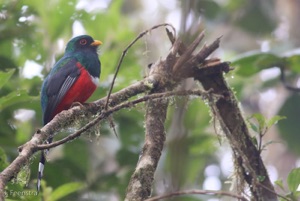Birding the wet season on the Pacific slope of the Andes around Mindo doesn’t often come with a lot of blue skies, but it does come with a lot of blue birds… and yellow ones, and red ones, and green ones, and various combinations of those colors and more. With stops at a range of elevations from near tree line to humid lowlands, plus access to the well-developed birding infrastructure of Ecuadorian eco-tourism hub of Mindo, we found nearly three hundred species including 35 species of hummingbirds and 33 species with “tanager” in their names. Those birds were complemented by quality local specialties like Crested Guan, Lyre-tailed Nightjar, Toucan Barbet, Plate-billed Mountain-Toucan, Orange-breasted Fruiteater, and Dusky Chlorospingus. Pretty orchids, colorful lizards, and great big beetles all added to the good time.
Though we picked up a few birds around our intro lodge in Puembo like Vermillion Flycatcher, Scrub Tanager, and piles of Saffron Finches, the big show began with our first stop at Reserva Yanacocha on the slope of the Pichincha volcano near tree line above Quito.
Here in the near-tree line elfin forest at about 3500 meters elevation we tackled some mixed flocks pulling out colorful Scarlet-bellied, Hooded, and Black-chested Mountain-Tanagers. As was typical for the rest of the tour, this elevation and habitat had its own set of hummingbirds including the creatively named Shining Sunbeam, and the insanely proportioned Sword-billed Hummingbird – perched with its bill held vertical to prevent unwanted tipping.
In addition to that “easy” stuff we also had nice looks at a White-browed Spinetail as it obliviously rummaged around in some vegetation just off the trail. After a full morning there and a hot lunch, we bumped down hill through the Tandayapa valley, stopping for some White-capped Dippers, cows in the road, etc. before arriving at Septimo Paraiso outside of Mindo, our base for the coming week.
The next day we started right out the door of the lodge, birding the beautiful cloud-forest preserve. We saw the sleeping Common Potoo and watched a Strong-billed Woodcreeper tearing up some mossy branches before rain changed our plans and we headed for one of the area’s newer bird-feeding stations a few minutes up the road. For the rest of the morning we enjoyed point-blank views of Black-chinned Mountain-Tanagers, Red-headed Barbets, and Ecuadorian Thrushes. That afternoon we went lower in elevation to the Milpe reserve. Tiny Green Thorntails were abundant at the feeders by the headquarters while out over the forest Bronze-winged Parrots loafed in the canopy and Swallow-tailed Kites whipped around snatching bugs.
Our foray to the lowest elevation of the tour took us to the Rio Silanche reserve at about 450 meters above sea level. Though most of the west lowlands have been deforested and converted to agriculture, this little island of rainforest remains and is a must when birding the area. From the reserve’s tower we saw both
White-tailed and Blue-tailed Trogons, Orange-fronted and Red-headed Barbets, Cinnamon and Guayaquil Woodpeckers, Purple-throated Fruitcrows, and lowland tanagers such as Tawny-crested and Scarlet-browed. There was also a Scarlet-rumped Cacique nest hanging from a branch at arms-reach off the tower corner. The adults were pretty annoyed that we were there, but if we turned our backs and huddled in the far corner of the platform, they seemed to tolerate our presence.
The next day was spent in the thick mossy cloud forest a few hundred meters higher in elevation than the lodge. A rarely traveled road gave us easy access to this special habitat. From here we saw Plate-billed Mountain-Toucans, Capped Conebills, and some drab little things like Flavescent Flycatcher, and the well-named Smoke-colored Pewee (that looks the same no matter how foggy it is). Mid-day we visited Pacha Quindi, the nature reserve owned by expats Tony and Barbara, who have some of the best hummingbird feeders in Ecuador. Not just their feeders, which were loaded with Booted Racket-tails, Violet-tailed Sylphs, and twelve other hummingbird species, but the fruiting trees around their property were attracting a good mix of birds
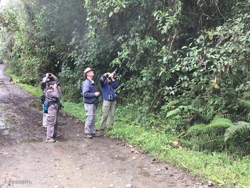
including the bizarre Toucan Barbet, as well as Metallic-green Tanager, Black-capped Tanager, and a snappy male Black-and-white Warbler. All that from a back porch was not too shabby at all. We spent most of the day there just soaking it in. On the way back to the lodge we made a quick stop for a Green-and-black Fruiteater and a Gorgeted Sunangel just catching that little bit of light coming through the clouds and leaves to wink brilliant purple in the dark forest.
Though birding isn’t known for its celebrities, Angel Paz is an A-lister, and a living legend in tropical birding. His all-inclusive birding experience features a continuous parade of difficult, skulky forest birds that he’s painstakingly conditioned to respond to his calls (and gifts of fresh earthworms). We started by watching a lek of Andean Cock-of-the-rock as they screeched and bounced around. Then he threw some bananas on the ground and a family of Dark-backed
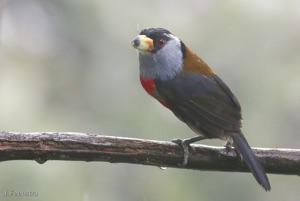
Wood-Quail warily shuffled out of the forest for them. Up the road, we pulled over, and he called in a Yellow-breasted Antpitta. Then we walked down a dark forest trail and he called in both a tiny Ochre-breasted Antpitta, and a rare and local Moustached Antpitta. And, if all that weren’t enough, at the end of his tour we sat at some tables near some bird feeders while Angel’s wife cooked us an Andean breakfast of bolón (a fried ball of plantain dough stuffed with chicken), empanada, and coffee. Later that afternoon we started with a leisurely stroll around the hotel grounds, but, since the weather was good, we drove down through Mindo town,
found a Sunbittern in the road (which did spread its magnificent wings), then waited until dusk to see Lyre-tailed Nightjars sallying off of a cliff, the male’s long tail streamers silhouetted against the evening sky. A pair of Mottled Owls back at the lodge got going and gave us nice views before it was time to call it a night.
For our final full day we drove out to another ridge where the cloud forest would hold yet another different
mix of birds. We started walking a quiet forest road seeing some nice things like Ornate Flycatchers, Powerful Woodpeckers, and a Spotted Barbtail, then we walked right into the Amagusa forest reserve with fruiting and flowering trees and hummingbird and banana feeders. We stayed here for the entire morning watching Glistening-green and Moss-backed Tanagers. A few very piggy Crimson-rumped Toucanets gobbled up bananas. Orange-breasted Fruiteaters sat in the trees overhead, and an Indigo Flowerpiercer poked around some little yellow flowers. It was a long drive out to this spot, but totally worth it.
On our final morning we worked our way out of this birding paradise and back toward civilization. We started back in higher
elevation cloud-forest to clean up some misses and were rewarded with a nice flock including a cooperative Cinnamon Flycatcher, new for us Blue-and-black Tanager, and more Beryl-spangled Tanagers. We also had a pair of feisty Plain-tailed Wrens, a bird not known for its birding-group cooperation, and then three male Masked Trogons perched over the road. Leaving the forest, we stopped at a new highway restaurant with a great view of the canopy. Perched Red-billed Parrots, and a flock including flashy Blue-necked Tanagers and Silver-throated Tanagers were nice. We ate lunch while watching more hummingbirds, then made the drive back across the Quito with a quick highway stop for an Andean Gull, and we were back where we started in Puembo: beers, dinner, and the end of a great week.

